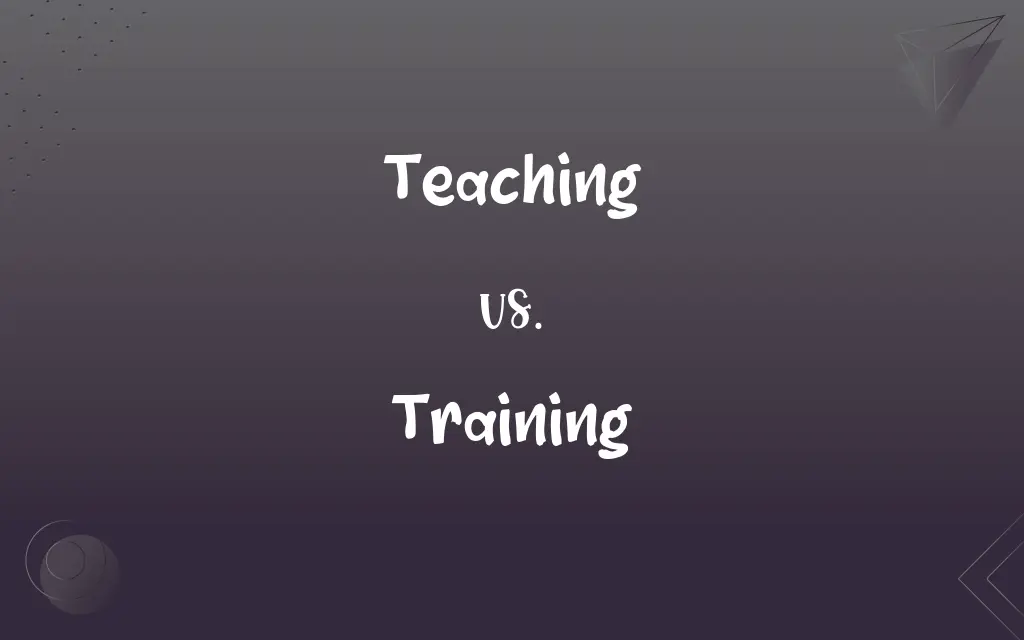Teaching vs. Training: What's the Difference?
Edited by Aimie Carlson || By Harlon Moss || Updated on October 7, 2023
Teaching primarily focuses on imparting knowledge and intellectual skills, while training aims at developing physical skills or specific abilities. Both involve a transfer of knowledge or skills from one entity to another.

Key Differences
Teaching, often seen in educational settings, emphasizes sharing knowledge or information with students. The teaching process focuses on enlightening and helping individuals to understand and remember specific information or knowledge. On the other hand, training often takes place in both educational and non-educational settings, focusing on skill development, often related to performing specific tasks or actions.
Teachers typically navigate through theoretical aspects, providing broad-based knowledge and fostering analytical thinking. Teaching thus spans various subjects and disciplines, from humanities to sciences. Conversely, training can be highly specialized and is often skill-specific, entailing a coach or trainer guiding trainees through specific routines or protocols to enhance particular abilities or skills.
Teaching frequently involves classroom settings, use of lectures, discussions, and various educational materials to engage and instruct students. The goals are usually centered around academic achievement and personal development. Training, however, may occur in various environments such as a gym, workshop, or other specialized venues, where practical application and repetitive practice of a specific skill are paramount.
In teaching, assessments are often utilized to gauge understanding, knowledge retention, and application. Various methods like examinations, assignments, and projects are used to appraise academic performance. In the sphere of training, evaluation is frequently based on performance metrics, precision, speed, and effectiveness in executing the learned skill or task.
Teaching often targets cognitive and affective development and aims to broaden perspectives, instill values, and foster critical thinking. It helps in shaping an individual’s worldview and intellectual abilities. Contrarily, training zeroes in on enhancing capabilities, often honing in on the psychomotor domain, to facilitate the proficient execution of tasks or actions in professional or recreational settings.
ADVERTISEMENT
Comparison Chart
Focus
Broad knowledge and understanding
Specific skills and applications
Setting
Primarily educational environments
Varied, task-specific environments
Approach
Theoretical and informational
Practical and skill-oriented
Assessment
Knowledge-based evaluations
Performance-based evaluations
Outcome
Intellectual development
Capability enhancement
ADVERTISEMENT
Teaching and Training Definitions
Teaching
Teaching is an act of imparting knowledge.
Her style of teaching involves a lot of group activities.
Training
Training involves developing specific skills or behaviors.
Her training for the marathon involves running various terrains.
Teaching
Teaching often occurs in formal educational settings.
The teaching of mathematics has evolved significantly over the decades.
Training
Training often requires repetitive practice.
His training in martial arts enhances his discipline and physical fitness.
Teaching
Teaching aims to cultivate intellect and character.
His teaching always encouraged students to think critically.
Training
Training aims at achieving proficiency in a particular activity.
Continuous training is essential for mastering a musical instrument.
Teaching
Teaching encompasses facilitating learning in others.
Effective teaching requires a balance of discipline and encouragement.
Training
Training often has a specific goal or outcome in mind.
The training program was designed to enhance their customer service skills.
Teaching
Teaching may involve various methods and approaches.
In teaching language, she always incorporates cultural lessons.
Training
Training can be provided for both physical and mental activities.
Her training in data analysis enabled her to interpret complex datasets proficiently.
Teaching
The act, practice, occupation, or profession of a teacher.
Training
The process or routine of one who trains.
Teaching
Something taught.
Training
The state of being trained.
Teaching
Often teachings A precept or doctrine
The teachings of Buddha.
FAQs
Can training have a teaching component?
Yes, training can incorporate teaching components when theoretical knowledge is needed to understand or improve the skill being developed.
Can teaching and training occur simultaneously?
Yes, teaching and training can be interwoven when knowledge acquisition and skill development are needed concurrently in a learning program.
What is the fundamental purpose of teaching?
The primary purpose of teaching is to impart knowledge and facilitate learning in various domains, fostering intellectual and moral development.
How do learners usually engage in training sessions?
Learners engage in training sessions through active participation, practice, observation, and feedback, focusing on skill acquisition and enhancement.
Are there certifications needed for professional training?
Depending on the field and jurisdiction, certifications might be required to provide professional training in specific areas like healthcare, fitness, or vocational training.
Are there different types of training?
Yes, training types can include on-the-job training, off-the-job training, apprenticeships, and various forms specific to skills or industries.
Is experiential learning part of teaching or training?
Experiential learning can be part of both teaching and training, emphasizing learning through experience and reflection.
How does training primarily differ from teaching?
Training primarily focuses on enhancing specific skills or abilities through practice and instruction, often related to physical tasks or particular professional skills.
Is teaching more theoretical than training?
Generally, teaching tends to be more theoretical, emphasizing knowledge, understanding, and cognitive development, while training is usually more practical and skill-oriented.
What are common methods used in training?
Training methods often involve hands-on practices, simulations, workshops, demonstrations, and exercises focused on skill development.
Is pedagogy related to teaching or training?
Pedagogy is primarily related to teaching, concerning the theory and practice of education and instructional methods.
Can training be self-directed?
Yes, training can be self-directed, where individuals engage in skill development activities independently, though having a trainer might enhance outcomes.
Is teaching always done by certified teachers?
Not necessarily; while formal education often involves certified teachers, teaching can also be done by experts, enthusiasts, or knowledgeable individuals in informal settings.
Is the duration of training programs standardized?
No, the duration of training programs can vary widely, depending on the skill, objectives, and the learner’s proficiency level.
How crucial is the role of a teacher in teaching?
Teachers play a pivotal role in teaching, facilitating learning, guiding students, and fostering a conducive learning environment.
Can technologies be utilized in both teaching and training?
Absolutely; technologies like e-learning platforms, virtual reality, and educational software can be utilized in both teaching and training to enhance learning experiences.
How is effectiveness measured in teaching?
Effectiveness in teaching is often measured through assessments, student feedback, and evaluations of knowledge retention and application by students.
Can anyone undertake training?
While most people can engage in training, the specific prerequisites or suitability might depend on the nature and demands of the training program.
Is teaching restricted to academic settings?
While commonly associated with academic settings, teaching can occur in various contexts, including non-academic and informal environments.
Does teaching always involve a formal curriculum?
Not always; teaching can be formal or informal and might not always adhere to a structured curriculum, especially in informal or non-traditional education settings.
About Author
Written by
Harlon MossHarlon is a seasoned quality moderator and accomplished content writer for Difference Wiki. An alumnus of the prestigious University of California, he earned his degree in Computer Science. Leveraging his academic background, Harlon brings a meticulous and informed perspective to his work, ensuring content accuracy and excellence.
Edited by
Aimie CarlsonAimie Carlson, holding a master's degree in English literature, is a fervent English language enthusiast. She lends her writing talents to Difference Wiki, a prominent website that specializes in comparisons, offering readers insightful analyses that both captivate and inform.































































